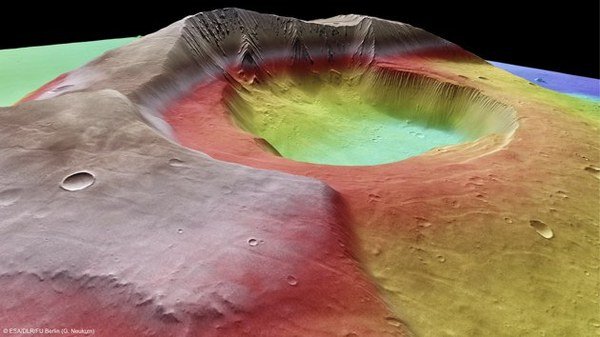The European Space Agency recently released stunning images of one of the planet's most striking features: the Tharsis Tholus volcano.
The area surrounding the mountainous landmark is relatively bare, causing the huge Martian structure to stand out. When active, Tharsis Tholus was likely much larger than it is today. Image Credit: ESA/DLR/FU Berlin (G. Neukum). Photo courtesy of Tecca
The planet Mars is a bit of an obsession for the human race. We've romanticized the red planet in everything from movies to video games, and we can't seem to get enough of the barren, desert-like planet. The European Space Agency isn't immune to Mars lust, and the organization recently released some stunning images of one of the planet's most striking features: the Tharsis Tholus volcano. Presented with false color to highlight its geographical features, the once-lively mountain is still a sight to behold. Join us as we take a tour of a true Martian landmark. Image Credit: ESA/DLR/FU Berlin (G. Neukum). Photo courtesy of Tecca
The Tharsis Tholis volcano stands 5 miles tall on the rocky Martian landscape, dwarfing the tallest volcanoes on Earth. Ojos del Salado on the Argentina-Chile border comes closest, measuring 4.2 miles tall. Image Credit: ESA/DLR/FU Berlin (G. Neukum). Photo courtesy of Tecca
The expansive crater located in the center of the volcano resulted from the loss of supportive magma that the mountain spewed billions of years ago. With the interior of the volcano lost, its roof caved in, forming the giant hole we see today. Image Credit: ESA/DLR/FU Berlin (G. Neukum). Photo courtesy of Tecca
Over the course of billions of years, Tharsis Tholus has become dotted with the scars of small to medium-sized impacts from space debris. The mountain is in an advanced state of erosion, making it particularly interesting to scientists looking to study the history of the red planet. Image Credit: ESA/DLR/FU Berlin (G. Neukum). Photo courtesy of TeccaTharsis Tholus' large size is aided by the relatively low gravity of Mars. With less than half of the gravitational force of Earth, it is easier for huge geographical features to exist on the Martian landscape. Image Credit: ESA/DLR/FU Berlin (G. Neukum). Photo courtesy of Tecca







0 comments:
Post a Comment